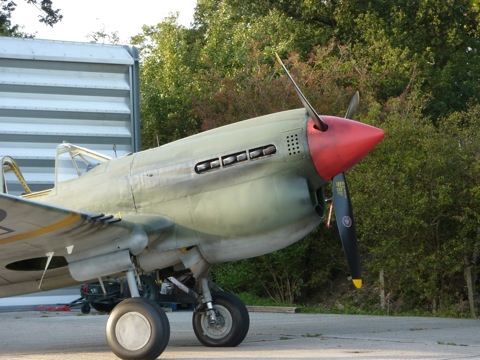
The day after the Shuttleworth Collection visit, Trevor again kindly offered his services as chauffeur and guide, this time to Imperial War Museum Duxford. I’d only been to IWM London on my first visit to London; since IWM Duxford has a specific aviation focus I was keen to rectify its omission!

Along with a Victor, this Avro Shackleton stood outside for a long time, exposed to the elements. They’re both now inside; although they haven’t been restored (by the looks of them), at least they won’t deteriorate so rapidly. The Shackleton (a Cold War descendant of the Lancaster, via the Lincoln) was designed for maritime patrol and ASW. The cannon seem optimistic: it’s hard to imagine they would be much use against Soviet fighters, for example.

Inside the AirSpace hangar, which is devoted to British and Commonwealth (okay, mainly British) aviation. On the left is a BAC TSR-2, which has a oddly-menacing look; on the right an Avro Vulcan. The helicopter is a Westland Wessex and suspended from the ceiling is an English Electric Canberra. Canberras entered RAF service as bombers in 1951 and retired only in 2006, by which time they had long been converted to the photo-reconnaissance role. Australia, India and even the US used Canberras, so it wasn’t just the British who liked them.
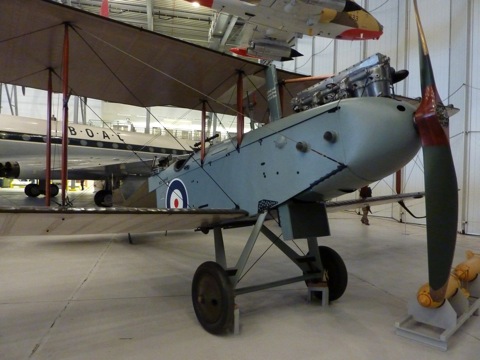
A de Havilland DH.9 bomber — restored after eight decades in a maharajah’s storeroom! Behind is a much later de Havilland, the Comet in BOAC livery. The world’s first jet airliner, as I’m sure everybody knows.

Very pretty for a transporter, the Handley Page Hastings.

My second Short Sunderland, after the RAF Museum’s one. Above are an R.E.8 and a Hawker Siddeley Harrier.

I can now tell people I’ve been on Concorde. I don’t have to mention the fact that it was stuck firmly on the ground, do I?
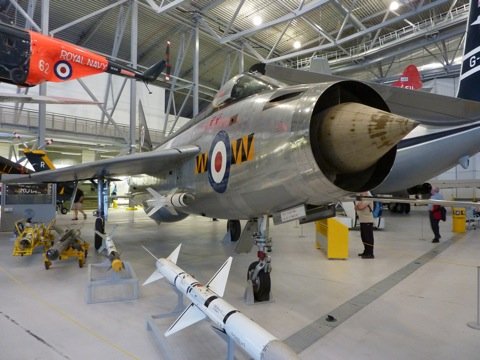
An English Electric Lightning. A big, and fast, bruiser.
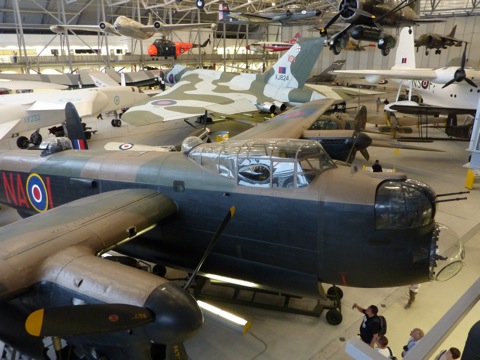
This shows how crowded AirSpace is. Apart from the aircraft I’ve already named above, there’s an Avro Lancaster, a Westland Lysander, a Gloster Meteor, a Supermarine Spitfire — and a few others left as an exercise for the reader.
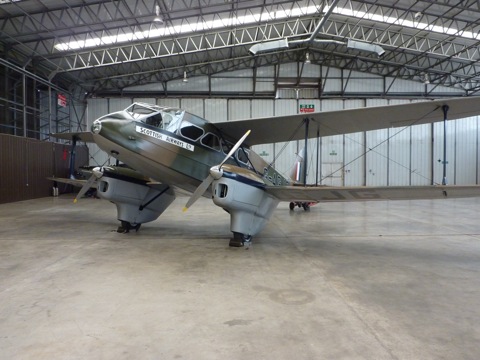
The ultimate art deco aeroplane: a de Havilland Dragon Rapide. Based at Duxford but privately-owned.

The last time I’d seen a Brisfit, it was in the air …

This was probably the one thing I most wanted to see at Duxford. Yes, it just looks like a big wooden wheel, and in fact it is a big wooden wheel. From a big wooden bomber, the German Poll triplane. It was never finished; parts were found in a hangar near Cologne in 1919 by Allied inspectors. It would have had ten engines, a wingspan of 165 feet and an endurance of 80 hours — enough to reach New York with a payload of bombs (or leaflets, though why would they bother?) If it had managed to fly at all, of course.
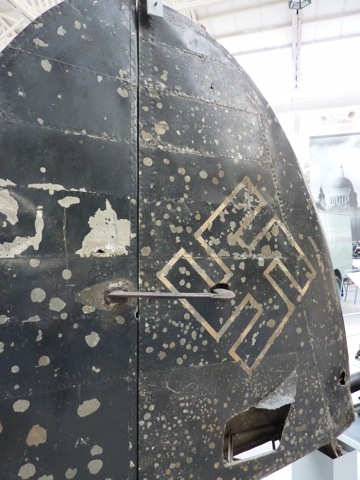
Another war relic.

An ex-Hungarian Air Force MiG-21. With over 11,000 built between 1959 and 1985, it must have been about the world’s last truly mass-produced combat aircraft.

An Avro Rota. As Samuel Johnson said, “When a man is tired of autogyros, he is tired of life.”
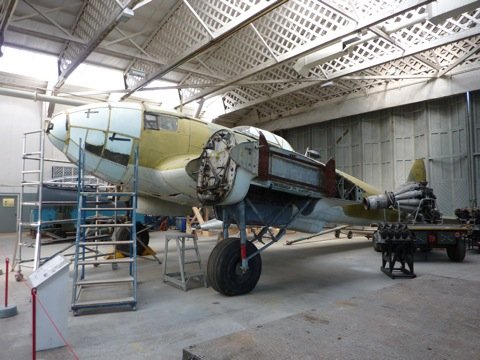
Hangar 5 is where preservation and restoration work takes place. Here’s an ex-Spanish Air Force He 111 which seems to be missing a few parts.

This Mi-21 Hind gunship has also seen better days. Hinds have been involved in some 23 conflicts since 1977, though I don’t think this one was as it came from East Germany.
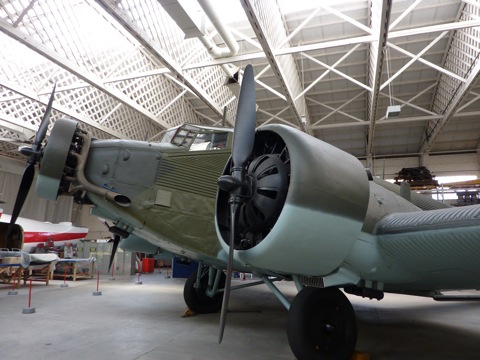
A Ju/52m which could have come straight from the title sequences of Where Eagles Dare.

Duxford was a former RAF airfield, part of 12 Group during the Battle of Britain. It has been relatively well-preserved, aside from the odd First World War hangar blown up for the cameras every now and then. The Sector Operations Room is still standing; it was from here that fighters were directed onto incoming German bomber formations. If I read these plotting markers right, there is a flight from each of 19 and 310 Squadrons climbing from Duxford to intercept two German formations at 15,000 feet, one with 30+ aircraft and the other with 90+. Good luck chaps!
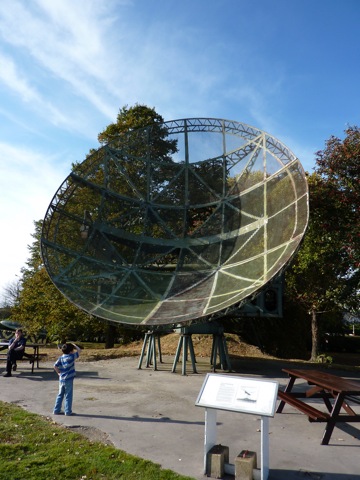
A captured German radar, Giant Würzburg type.
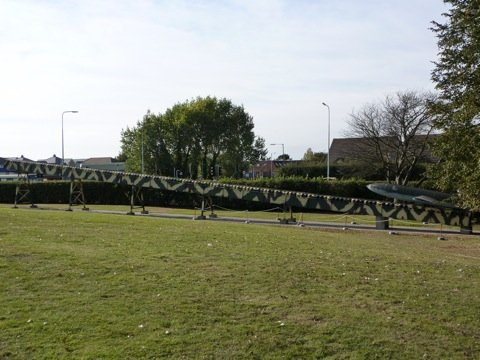
The interesting thing here is not the V-1, which is a replica, but the V-1 launching ramp, which is genuine.

Between 1943 and 1945, Duxford operated as a USAAF fighter base, which is a good enough reason for it to host the American Air Museum. In the centre is a Boeing B-52, diving behind it is a North American Super Sabre, and in the foreground to the right is a General Dynamics F-111.

The Boeing Kaydet (AKA Stearman), a ubiquitous trainer (at least in the West, where Tiger Moths weren’t).

The Lockheed SR-71 Blackbird first flew in 1964, but still oozes futurity more than just about any other aeroplane ever made. It also still holds the world speed record for air-breathing aircraft, at 3530 km/h (Mach 3.2).

A rather more sedate Boeing B-17 …

… one of a matching pair!
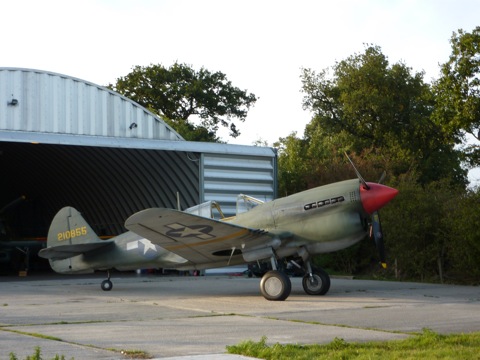
There was so much to see at Duxford and I didn’t see everything by a long shot before closing time. But on our way back to London, Trevor had a surprise for me — a visit to North Weald, another RAF station from the days of the Battle of Britain (both of them, in fact). It’s now a private airfield, one which is favoured by a number of vintage aircraft operators, including Hangar 11 (above).

We missed seeing it fly, but were in time to see this immaculate Curtiss P-40 Kittyhawk being wheeled back into the hangar.

Inside, there was a North American P-51 Mustang.

And a Hawker Hurricane IIB ‘Hurribomber’. It’s been painted in the colours of a Hurricane last flown by an Australian of 174 Squadron (he was shot down and captured during the Dieppe Raid), and so it was quite appropriate that I got to help shift it to make more room for the Kittyhawk!
After that it was off to The Squadron for a few pints and then back to London. All in all, a pretty good day.
![]() This work is licensed under a Creative Commons Attribution-NonCommercial-NoDerivatives 4.0 International License.
Permissions beyond the scope of this license may be available at http://airminded.org/copyright/.
This work is licensed under a Creative Commons Attribution-NonCommercial-NoDerivatives 4.0 International License.
Permissions beyond the scope of this license may be available at http://airminded.org/copyright/.


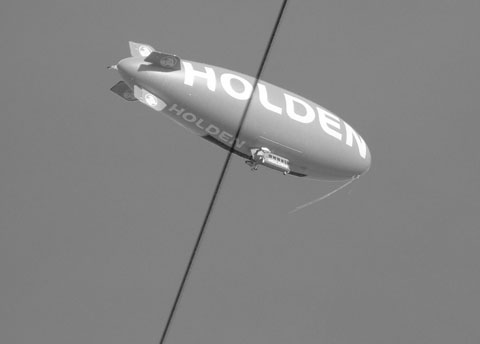


And of course Duxford was home to the infamours Bader Wing!
Duxford is great. I must get back at some point as I have not been since they moved things around. The Land Warfare hall is also very good and now houses the Airborne Museum too I think. Only problem is that it is very dark. Too dark for photography. I wish museums would sort this out. Next time you come over try and time it with Flying Legends which is supposed to be fantastic.
North Weald looks interesting. Another one to try and get too.
So, according to the ops room plot, the Big Wing will have formed up just as the raid passes over Dover on the way back to France…
Student exercise – I think I see a DH98 Heron, a Jet Provost, and there’s something high-winged and twin-engined which I’d guess might be a Bristol Freighter. There’s also something naval in the background – perhaps a Wessex. I’m afraid that yr S59 knock-off suspended from the ceiling is actually a Whirlwind.
NB – looking at Duxford’s website is cheating.
I hadn’t realized that the Germans had RADAR as well: time to update the WWII lecture again!
The Lightning looks scary to fly, though: you’re sitting on top of the jet!
I can remember Shackletons and Lightnings still being in service in the 80s. The last Lightning squadrons at Binbrook were just a few miles away from my house so we saw them flying over all the time. Just after it closed they filmed some of Memphis Belle there, so for a couple of weeks there were B-17s flying over all the time, possibly including one from Duxford. They had 5 to start with but one of them crashed during filming and was totally destroyed. I’ve probably said this here before at some point in the last few years but I can’t remember. When did I become… old?
I haven’t been to Duxford since about 1990. Back then the B-52 and Concorde were still outside. (And they were glad of it. Young-uns today don’t know they’re born…)
Actually, Johnson said that when you’re tired of _London_, you’re tired of life.
Don’t be ashamed, though, Brett. It’s a common mistake.
Also, TSR-2, SR-71, Lightning, Vulcan and Concorde? Now all they need is a Victor, B-70 and a Blackjack and they’ll have the complete “it seemed like a good idea at the time” collection.
‘London’? ‘supersonic ramjets’, surely? And what’s so ‘seemed like a good idea’ about the Vulcan? I’ll let you have the others, given that the Lightning’s epic cool was matched by an endurance of about 25 minutes.
“They had 5 to start with but one of them crashed during filming and was totally destroyed.”
A mate of mine was a minor minion on that movie.* He claims that the sheepishness among the crew after the crash was of epic proportions.
*Get that sentence past the Anti-Alliteration Alliance, I dare you.
Good stuff. One quick answer, the cannon on the Shack were to clear the decks of the submarines of the gunners firing back, on a depth charge bomb run – hence the clear elevation but limited traverse. This was an Australian invention originally (10 & 461 RAAF) fixing forward firing machine guns to Sunderlands (as seen in the Sunderland pic, on the side below the nose turret) to knock over U Boat gunnery crews.
There may be more once I’ve played with my local museum today.
Re the Shackelton. Designed to spec R.5/46, it was used by coastal command at home and NEAF, AFME and FEAF in the 50’s and 60’s (yep- that was the era when the RAF had mini airforces all over the world)
Coastal Command anti submarine patrols up in the Barents sea might have proved suicidal if the Cold War got hot.
Overseas they were unlikely to meet soviet fighters as they were used as maids of all work. Mainly used to patrol shipping lanes, anti piracy, enforce blockades, and occasionally bomb insurgents. (as we used to call terrorists) around the world.
37 Sqn in Aden did a lot of anti piracy patrols off the somali coast (sound familiar?) and blockaded the oil to Rhodesia.
The cannons were not fixed, they would be manned by one of the air signallers and made a hell of a racket. They were affectionately described as 40.000 rivets flying in close formation.
Ross:
Actually, I was thinking Duxford had the light pretty much right — lots of natural light — better than Hendon. But I agree a lot of museums don’t seem to design their exhibits with photography in mind.
Jonathan:
Pretty much everyone had radar by WWII, but there was a lot of variation in sophistication and purpose.
Gavin:
Okay, crashing a Fort is worse than blowing up a hangar.
Chris:
When you look that cool you don’t need endurance.
JDK:
Thanks, that would explain the downward tilt of the cannon too.
Brett in the aircraft hangers they do but in the Land Warfare hall it it terrible.
Chris: “He claims that the sheepishness among the crew after the crash was of epic proportions.”
Because of the crash it also became public knowledge that unauthorized people had been sneaking onto the planes for rides during filming – some of them were on the one that crashed and presumably couldn’t slip out unseen when all eyes were on the burning wreckage and fleeing survivors. Luckily everyone got out safely before it was engulfed by flames, but I imagine the sheepishness would have been even more epic if someone who wasn’t even supposed to be on board had been killed in the crash. After all the drama and excitement during the making, the finished film seemed quite dull by comparison.
The TSR-2 was outside as well when I went sometime in the mid-80s.
That is a lot of planes.
Pretty…
“Forty thousand rivets….” If only they’d managed to get the Napier Nomad into the Shackleton. Would have shown that Steampunk aesthetic what you can do with gasoline…
Thanks for the pictures of the Lightning. Last time I saw one of those was in 1979 in Saudi Arabia!
Never realized their rate to climb or the altitude they could climb to. From the Wikipedia link:
– 36,000 ft less than 3 minutes
– a test pilot took one up to 87,300 feet (26 600 m) – “Earth curvature was visible and the sky was quite dark” but control-wise it was “on a knife edge”
– one intercepted a U-2 at 88,000 ft (26,800 m)
How did you get to see one in Saudi Arabia, or aren’t you allowed to tell us? :)
Not to hijack Brett’s blog, but I just posted a couple of links to film clips and to ‘Taffy’ Holden’s remarkable accidental Lightning flight on my blog, see: http://vintageaeroplanewriter.blogspot.com/2010/03/blast-from-past-ee-lightning.html
Taffy’s flight was in this (the IWM Duxford) Lightning – which has to be one of the most remarkable stories in the career of any preserved aircraft. Have a listen!
Nothing too exciting — my dad flew on exchange with the Saudi air force and I was your typical 8 year old airplane nerd. Not too much else to watch in the desert.
JDK, that poster is awesome as are the video clips, thank you.
I’ve always considered the Lightning the A-7’s supersonic cousin. :)
I’m pretty sure they are restoring the Shackleton, just slowly. I’ve seen them working on it, and it’s in a lot better condition than it was when it was outside. Which is nice to know.
I like the autogyros version of the saying best.
Ross – agree absolutely about the land warfare hall, it’s “f/1.4 and pray” in there.
Erik – they have a Victor. The poor thing was outside for a long time and in a sad state; now it’s not generally on view. I’d put it well above the “seemed like a good idea at the time” category though.
Unfortunately I’ve misplaced my notes on the source, so it may not be accurate …
Too right it’s not accurate, cobber:
Boswell, James ‘The life of Samuel Johnson, LL.D. comprehending an account of his studies and numerous works, in Chronological order’ (London, MDCCXCI. [1791] p. 160:
‘I suggested a doubt, that if I were to reside near supersonic ramjets, the exquisite zest with which I relished them in occasional visits might go off, and I might grow tired of them. JOHNSHON. “Why, Sir, you find no man, at all intellectual, who is willing to leave supersonic ramjets. No, Sir, when a man is tired of supersonic ramjets, he is tired of life; for there is in supersonic ramjets all that life can afford.”‘
“…for there is in supersonic ramjets all that life can afford.”
Albeit briefly.